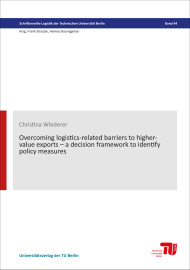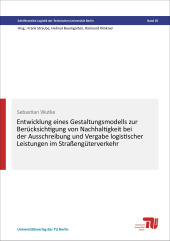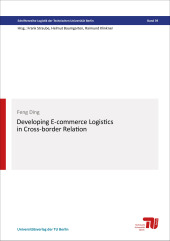Overcoming logistics-related barriers to higher-value exports – a decision framework to identify policy measures

Size: 441 pages
Format: 14,8 x 21,0 cm
Publishing year: 2021
ISBN 978-3-7983-3230-0Format: 14,8 x 21,0 cm
Publishing year: 2021
16,50 €
Logistics is key to a country’s trading opportunities. Poor trade logistics performance, measured in the cost and complexity of importing and exporting, precludes many countries from diversifying their economies and can hamper trade, growth and employment. This is acutely relevant for developing countries, where a frail logistics environment, i.e., the combination of logistics infrastructure and services, is often a factor in weak trade. While trade consists of imports and exports, exports are crucial to a country’s development due to their potential to increase income and employment. Supply chain delays increase transportation costs and hence product costs, thus decreasing the competitiveness of exports. They force companies to hold higher inventory to avoid production stoppages due to delays in procuring preliminary products. While logistics services are mostly provided by private actors, governments play a key role in ensuring a well-functioning logistics environment, for example, through providing public infrastructure, customs procedures, or vocational training. Given limited resources, identifying and prioritizing investments are crucial tasks for developing nations.
This dissertation develops a decision framework for the public sector as to which logistics interventions to carry out in a country wishing to facilitate higher-value exports. Higher-value exports here refer not just to a higher amount of exports, but to a higher value added of exports. The framework is applied to three product categories: automotive products, perishable agricultural products, and high-tech manufacturing. It is then applied to Vietnam, Morocco, and Kyrgyzstan, three middle-income countries representing different geographies, population sizes, and industrial structures. Methods to develop the framework include structured and semi-structured interviews, data analyses from public sources, and a review of the literature.
The results include product-category-specific logistics requirements, gap analyses for the three countries, and policy recommendations for measures to improve logistics for high-tech manufacturing in Vietnam, automotive products in Morocco, and perishable agricultural goods in Kyrgyzstan. Although the suggested logistics measures are applicable to the three case study countries, the framework’s first part (target set-up of the logistics environment and logistics requirements) can be applied to other countries wishing to facilitate exports in the three product categories. Guidelines on potential measures to improve the logistics environment for the three product categories are included and can be used by policymakers in other countries. The framework developed here can also be applied to other product categories. It uses a structured approach that enables identifying recommended policy measures even with a narrow empirical base of public country-level, logistics-related data and insights from interviews with logistics stakeholders.



